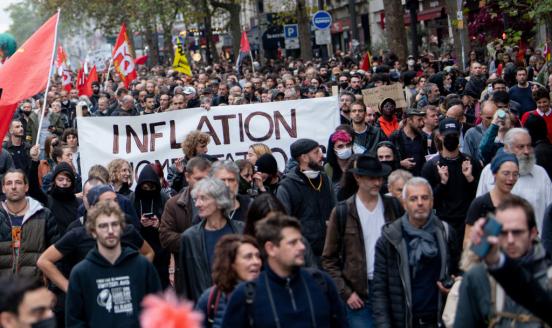New EMU stabilisation tool within the MFF will have minimal impact without deeper EU budget reform
The European Commission’s proposal for a new stabilisation instrument inside the EU budget for the countries of the economic and monetary union is dis

On May 2, the European Commission put on the table a number of proposals for the future of the EU budget after 2020. The most disappointing part of the Commission’s plan for the next MFF 2021-27 is the means by which it wants to establish a stabilisation instrument inside the EU budget for countries of the economic and monetary union (EMU).
These details were particularly long-awaited, given that the Commission had announced in its December 2017 “Deepening of the EMU” package that, in order to deal with asymmetric shocks, it preferred not to create a separate instrument for EMU countries. Instead, the Commission intends to build such a tool inside the EU budget, arguing that the euro is the official currency of the EU and that tools to strengthen the monetary union should not be separated from the financial architecture of the whole EU.
The Communication on the next MFF, published on May 2, clarifies the December proposal by providing some details as to how the Commission expects to put its EMU stabilisation tool in place. Now called the “European Investment Stabilisation Function” (EISF), the proposed tool comprises two main components – a loan element and a grant element – which I will analyse in turn.
The loan component of the proposal
The first part of proposal for the EMU stabilisation function pertains to the possibility that the Commission could offer back-to-back loans of up to €30 billion for countries facing asymmetric shocks that they cannot manage on their own, but which had sound fiscal and economic policies before the shock. According to the Commission, this new lending facility would be a good complement to the European Stability Mechanism (ESM) by being unconditional and automatic. Decision-making should indeed be easier than at the ESM (which requires the unanimity of its members to approve programmes) because a simple majority in the Council should be sufficient to disburse EISF funds, after the Commission has proposed to do so. I have three simple remarks on this new lending facility.
First, on its size – €30 billion is a very small amount with which to approach large asymmetric shocks. It is roughly equivalent to a third of the loans made to Ireland between 2010 and 2013, and would thus not allow lending to multiple countries simultaneously. Compared to the ESM’s lending capacity, which is €500 billion, this is pretty much negligible – especially considering that the €500 billion of the ESM might not have been enough to counter a self-fulfilling crisis on European sovereign debt markets if it had not been complemented with the ECB’s Outright Monetary Transactions (OMT) programme, the firepower of which is unlimited ex-ante.
Second, on the origin of the funds; the Commission has decided that the loans would come from the EU budget, and that the EU would borrow money to make these loans. Under the current Treaty (Article 310.1), the EU cannot borrow to finance its budget, but it can do it to finance back-to-back loans to countries (Article 122.2). In its budget, the EU currently has three lending programmes to raise funds and provide financial assistance to countries experiencing financial difficulties: the Balance of Payments (BoP) assistance for non-euro EU countries, the European Financial Stability Mechanism for all EU countries, and the Macro-Financial assistance (MFA) for non-EU partner countries. The funds are raised by issuing bonds on international financial markets on behalf of the EU. The Commission then lends this money to the country in need at the same interest rate. This allows the countries receiving assistance to benefit from the low rates available to the EU as a highly-rated borrower.
However, this means that the amounts are strictly limited. For the BoP facility, the outstanding amount of loans to be granted to Member States is limited to €50bn (Regulation 431/2009). For the EFSM, it is limited by the “margin available under the own resources ceiling for payment appropriations” (Regulation 407/2010), to be sure that the Commission can call additional resources from Member States to service the debt (principal and interest) if the debtors default. For the MFA, the mechanism is different because the EU has established a Guarantee Fund for External Actions (Regulation 480/2009) constituted by gradual payments from the EU budget to cover potential defaults, so it does not have to rely on the margin available under the own resources ceiling for payment appropriations. This margin represents around €35 billion per year, and will continue to be around that level in the next MFF according to the Commission’s proposal. When the EFSM was created, the Commission had estimated that this level implied that the total lending capacity of the EU based on the margin was around €110bn (€50bn for the BoP, and the rest – i.e. €60 billion – for the EFSM). The Council regulation proposal laying down the MFF for 2021-27 (also published on May 2) confirms that the Commission foresees that the lending facility of the EISF will operate under the same limit as the EFSM and the BoP facility (i.e. the margin available under the own resources ceiling for payment appropriations).
I see two main issues with the EISF proposal. First, this programme is not additional, as it does not increase the lending/borrowing capacity of the EU. The total outstanding amount of loans available for the BoP facility, the EFSM and the EISF is constrained by a single limit. So, there is little value in creating a new facility, as this would mechanically reduce the lending capacity of the EFSM by €30bn to create the EISF. Second, there is not much difference between the EISF and the EFSM. They have the same objective – to provide financial assistance to Member States through loans guaranteed by the EU budget – and the same limited resources with which to do it. So, it is difficult to understand how creating this new lending facility would help increase stabilisation in the monetary union.
Sure, some little details concerning the eligibility conditions and the decision-making are slightly different: the EISF would be more automatic – as long as countries have sound policies ex ante – and would be unconditional ex post. But the main problem of the EFSM – its limited size due to the constraints put on the EU budget – would still apply and make the new EISF irrelevant. To make this new lending facility relevant, the Commission could have proposed to the Member States a significant increase in the margin available under the own resources ceiling for payment appropriations, which limits how much the EU can borrow/lend, but it did not to go in that direction.
Finally, on the overall logic underlying the EISF lending facility; if this lending facility is reserved for countries with sound fiscal and economic policies, there is a good chance that a crisis involving this type of country would be a self-fulfilling liquidity crisis. Liquidity crises are supposed to be dealt with through the OMT programme of the ECB, conditional on the participation of the country in an ESM programme. If there is something crucial to fix in the emergency liquidity provision of the euro area, it is that the ESM should be reformed to add an unconditional liquidity track for countries suffering pure liquidity crises, to give them easier access to the OMT – as proposed, for instance, in Claeys (2017). But there is no need to add a small and redundant lending facility to the list of crisis tools that the euro area created during the crisis (even if this is politically easier than reforming the ESM).
The grant component of the proposal
In addition to the new lending facility, the Commission also plans to include a risk-sharing component in its proposal to create an EMU stabilisation function. The Commission’s proposal on that front plans for the building of a rainy-day fund with €600 million per year, financed with a share of the seigniorage profits from the Eurosystem. This should then be used to provide “an interest rate subsidy” to cover the interest rates that countries would pay on the back-to-back loans discussed above. In this way, countries using the EISF lending facility would not only benefit from the low interest rates available to the EU, but would literally pay 0% interest rates on these loans.
Again, the major issue with this proposal is that it would be totally irrelevant in a crisis. Imagine a country in need of financial help, receiving the whole €30 billion loan from the EU at an interest rate of 2% (the average interest rate paid currently by the EU on its outstanding debt is 3% but given the currently lower level of interest rates, 2% might be a good first guess for the interest paid on the bonds that will be issued during the next MFF). Thanks to the proposed scheme, the country could then recover €600 million as an interest rate subsidy. However, during a crisis, what would matter would not be the interest paid on this relatively minor loan, but the potential overall increase in interest payments that the country might face and its impact on its public finances. For example, in the heat of the crisis, interest payments in Spain increased by €6 billion (i.e. 10 times the proposed interest rate subsidy) in a single year in 2011, and by €20 billion during the whole crisis (from €16bn per year in 2006 to €36bn in 2014). This shows how irrelevant the level of risk-sharing provided by the proposed grant component of the stabilisation tool really is.
Going further in this direction, a more ambitious proposal could have been to create a true EMU rainy-day fund financed with all distributable Eurosystem profits, rather than just on a small share of them. These profits averaged €11 billion between 1999 and 2007 (and €13 billion per year between 1999 and 2016, as calculated by Chiacchio, Claeys and Papadia, forthcoming). This means that, had such a fund existed, it would have accumulated almost €100 billion before the start of the crisis. This would have represented around 1% of euro-area GDP and would have provided enough stabilisation in several countries of the euro area suffering from large shocks for at least a couple of years (see, for instance, the calculations in Claeys, 2017).
In fact, in addition to the interest subsidy, the Commission mentions in its communication that the European Investment Stabilisation Function could be “later” complemented by an insurance mechanism “outside of the EU budget”, financed from voluntary contributions of Member States to build a rainy-day fund. Even though this could not be based on voluntary contributions, as that would create an adverse selection problem, this potential solution – not explored by the Commission and instead left for the future – would nevertheless constitute a real answer to the stabilisation issues of the euro area, contrarily to the current, more detailed, proposals.
Conclusions
Overall, the Commission’s proposals on a stabilisation function will not be a game-changer for stabilisation policy in Europe. The idea to include a stabilisation tool for the EMU in the EU budget is not bad per se, as it would eschew the creation of a new ad-hoc (probably inter-governmental) institution, and an additional political and financial wedge between euro and non-euro area countries. Nevertheless, the current form of the EU budget is based on a rather complicated set of rules, allowing for low flexibility and very limited borrowing/lending capacity.
Therefore, building a proper stabilisation function inside the EU budget would have necessitated a much deeper reform of the budget, which is not what the European Commission proposed on May 2nd for the next MFF. In fact, by mentioning that its current proposal could later be completed by another stabilisation tool “outside the EU budget”, the Commission acknowledges implicitly that it is difficult to put together the necessary resources to build a meaningful stabilisation tool inside the EU without rethinking the whole EU budget from top to bottom (especially with other new EU priorities – migration, border control, security, innovation, etc. – also competing for a small amount of resources).
However, even though it is true that the EU budget is constrained, one should be careful about not mixing up causes and effects. As argued in Claeys and Wolff (2018), the constraints in the EU budget are a result of a desire by some Member States to prevent excess borrowing at the European level (that is why, in the past, Member States have not decided to increase the margin of the EU budget that would have increased the borrowing capacity of the Union). So, the real point of contention is not the legal constraints but the political desire of Member States to upgrade stabilisation capacities for the EMU.
The EU budget, as it is defined in the current Treaty, could be substantially modified to provide more stabilisation. To transform it into a form of insurance for large asymmetric shocks is possible, but would require a lot of political will. Once the political will is there, meaningful instruments can be built both within as well as outside the EU financial architecture.



